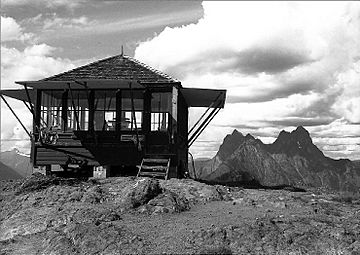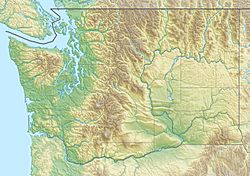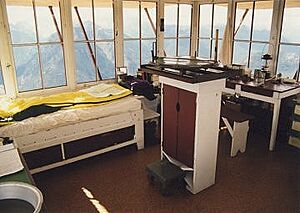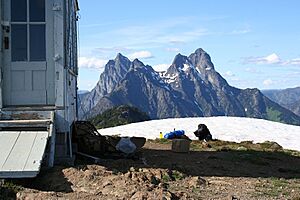Desolation Peak (Washington) facts for kids
Quick facts for kids Desolation Peak |
|
|---|---|

Desolation Peak Lookout with Mt. Hozomeen in the background
|
|
| Highest point | |
| Elevation | 6,102 ft (1,860 m) NGVD 29 |
| Prominence | 3,249 ft (990 m) |
| Geography | |
| Parent range | North Cascades |
| Topo map | USGS Hozomeen Mountain |
| Climbing | |
| Easiest route | Trail hike |
Desolation Peak is a mountain in the North Cascades of Washington state. It is about 6.2 miles (10 km) south of the border with Canada. You can find it in the Ross Lake National Recreation Area.
The mountain was first climbed in 1926 by Lage Wernstedt. He named it "Desolation Peak" because a big forest fire had burned the slopes bare that same year. At the top of the mountain, there is a small, wooden, one-room building. This is a fire lookout station that belongs to the National Park Service. The lookout is 15 miles (24 km) from the closest road. From here, you can see many miles of forest and lots of other mountain peaks.
The famous writer Jack Kerouac spent 63 days here in the summer of 1956. He worked as a fire lookout on Desolation Peak. He wrote about his experiences in several books, including The Dharma Bums, Lonesome Traveler, and Desolation Angels. He also wrote a collection of short poems called "Desolation pops."
The Desolation Peak Trail is a steep hike that leads to high meadows. It offers amazing views and takes you right to the fire lookout. It is a very popular hike, but it can be tough, especially along the East Bank Trail. The trail is often hot and dry.
In 2020, Lindsay Hagen made a short film about Jim Henterley. He is one of the people who still works as a watchman at the Desolation Peak Lookout.
Mountain Weather
Desolation Peak is in a climate zone called "marine west coast." This means it gets a lot of weather from the Pacific Ocean. Most weather systems move from the Pacific Ocean towards the Cascade Mountains.
When these weather systems reach the North Cascades, the tall mountains force the air upward. As the air rises, it cools down and drops its moisture. This causes a lot of rain or snow to fall on the Cascades. This process is called Orographic lift.
Because of this, the west side of the North Cascades gets a lot of rain and snow, especially in winter. During winter, the weather is often cloudy. But in summer, high-pressure systems over the Pacific Ocean bring clear skies. This means there is often little or no cloud cover during the summer months.
How the Mountains Formed
The North Cascades have some of the most rugged and dramatic landscapes in the Cascade Range. You can see sharp peaks, tall spires, long ridges, and deep valleys carved by glaciers. These amazing shapes were created by geological events that happened millions of years ago. These events also caused big changes in elevation, which led to different climates.
The Cascade Mountains started forming millions of years ago, during a time called the late Eocene Epoch. This happened because the Earth's huge North American Plate was slowly moving over the Pacific Plate. This movement caused many volcanic eruptions.
Also, small pieces of the Earth's crust, called terranes, came together. These pieces of oceanic and continental land helped create the North Cascades about 50 million years ago.
During the Pleistocene period, which was over two million years ago, huge sheets of ice called glaciers moved across the land. These glaciers advanced and then melted back many times. As they moved, they scraped away the landscape and left behind piles of rock. The "U"-shaped valleys you see today were carved out by these glaciers.
The combination of the land being pushed up (called uplift) and cracks forming in the Earth's crust (called faulting), along with the action of glaciers, created the tall peaks and deep valleys of the North Cascades.





